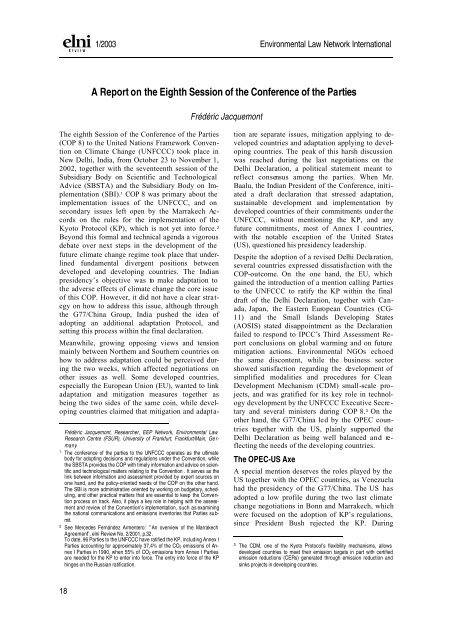elni NEWS - Öko-Institut eV
elni NEWS - Öko-Institut eV
elni NEWS - Öko-Institut eV
You also want an ePaper? Increase the reach of your titles
YUMPU automatically turns print PDFs into web optimized ePapers that Google loves.
18<br />
1/2003 Environmental Law Network International<br />
A Report on the Eighth Session of the Conference of the Parties<br />
The eighth Session of the Conference of the Parties<br />
(COP 8) to the United Nations Framework Convention<br />
on Climate Change (UNFCCC) took place in<br />
New Delhi, India, from October 23 to November 1,<br />
2002, together with the seventeenth session of the<br />
Subsidiary Body on Scientific and Technological<br />
Advice (SBSTA) and the Subsidiary Body on Implementation<br />
(SBI). 1 COP 8 was primary about the<br />
implementation issues of the UNFCCC, and on<br />
secondary issues left open by the Marrakech Accords<br />
on the rules for the implementation of the<br />
Kyoto Protocol (KP), which is not yet into force. 2<br />
Beyond this formal and technical agenda a vigorous<br />
debate over next steps in the development of the<br />
future climate change regime took place that underlined<br />
fundamental divergent positions between<br />
developed and developing countries. The Indian<br />
presidency’s objective was to make adaptation to<br />
the adverse effects of climate change the core issue<br />
of this COP. However, it did not have a clear strategy<br />
on how to address this issue, although through<br />
the G77/China Group, India pushed the idea of<br />
adopting an additional adaptation Protocol, and<br />
setting this process within the final declaration.<br />
Meanwhile, growing opposing views and tension<br />
mainly between Northern and Southern countries on<br />
how to address adaptation could be perceived during<br />
the two weeks, which affected negotiations on<br />
other issues as well. Some developed countries,<br />
especially the European Union (EU), wanted to link<br />
adaptation and mitigation measures together as<br />
being the two sides of the same coin, while developing<br />
countries claimed that mitigation and adapta-<br />
Frédéric Jacquemont, Researcher, EEP Network, Environmental Law<br />
Research Centre (FSUR), University of Frankfurt, Frankfurt/Main, Germany<br />
1 The conference of the parties to the UNFCCC operates as the ultimate<br />
body for adopting decisions and regulations under the Convention, while<br />
the SBSTA provides the COP with timely information and advice on scientific<br />
and technological matters relating to the Convention . It serves as the<br />
link between information and assessment provided by expert sources on<br />
one hand, and the policy-oriented needs of the COP on the other hand.<br />
The SBI is more administrative oriented by working on budgetary, scheduling,<br />
and other practical matters that are essential to keep the Convention<br />
process on track. Also, it plays a key role in helping with the assessment<br />
and review of the Convention’s implementation, such as examining<br />
the national communications and emissions inventories that Parties submit.<br />
2 See Mercedes Fernández Armentero: ”An overview of the Marrakech<br />
Agreement”, <strong>elni</strong> Review No. 2/2001, p.32.<br />
To date, 96 Parties to the UNFCCC have ratified the KP, including Annex I<br />
Parties accounting for approximately 37,4% of the CO2 emissions of Annex<br />
I Parties in 1990, when 55% of CO2 emissions from Annex I Parties<br />
are needed for the KP to enter into force. The entry into force of the KP<br />
hinges on the Russian ratification.<br />
Frédéric Jacquemont<br />
tion are separate issues, mitigation applying to developed<br />
countries and adaptation applying to developing<br />
countries. The peak of this harsh discussion<br />
was reached during the last negotiations on the<br />
Delhi Declaration, a political statement meant to<br />
reflect consensus among the parties. When Mr.<br />
Baalu, the Indian President of the Conference, initiated<br />
a draft declaration that stressed adaptation,<br />
sustainable development and implementation by<br />
developed countries of their commitments under the<br />
UNFCCC, without mentioning the KP, and any<br />
future commitments, most of Annex I countries,<br />
with the notable exception of the United States<br />
(US), questioned his presidency leadership.<br />
Despite the adoption of a revised Delhi Declaration,<br />
several countries expressed dissatisfaction with the<br />
COP-outcome. On the one hand, the EU, which<br />
gained the introduction of a mention calling Parties<br />
to the UNFCCC to ratify the KP within the final<br />
draft of the Delhi Declaration, together with Canada,<br />
Japan, the Eastern European Countries (CG-<br />
11) and the Small Islands Developing States<br />
(AOSIS) stated disappointment as the Declaration<br />
failed to respond to IPCC’s Third Assessment Report<br />
conclusions on global warming and on future<br />
mitigation actions. Environmental NGOs echoed<br />
the same discontent, while the business sector<br />
showed satisfaction regarding the development of<br />
simplified modalities and procedures for Clean<br />
Development Mechanism (CDM) small-scale projects,<br />
and was gratified for its key role in technology<br />
development by the UNFCCC Executive Secretary<br />
and several ministers during COP 8. 3 On the<br />
other hand, the G77/China led by the OPEC countries<br />
together with the US, plainly supported the<br />
Delhi Declaration as being well balanced and reflecting<br />
the needs of the developing countries.<br />
The OPEC-US Axe<br />
A special mention deserves the roles played by the<br />
US together with the OPEC countries, as Venezuela<br />
had the presidency of the G77/China. The US has<br />
adopted a low profile during the two last climate<br />
change negotiations in Bonn and Marrakech, which<br />
were focused on the adoption of KP’s regulations,<br />
since President Bush rejected the KP. During<br />
3 The CDM, one of the Kyoto Protocol’s flexibility mechanisms, allows<br />
developed countries to meet their emission targets in part with certified<br />
emission reductions (CERs) generated through emission reduction and<br />
sinks projects in developing countries.

















